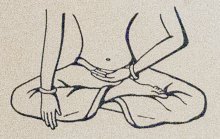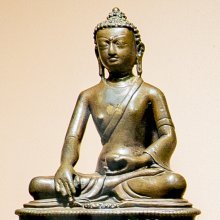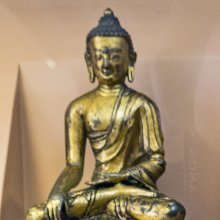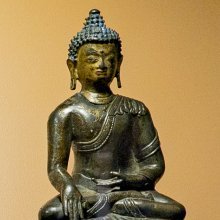Earth: 3 definitions
Introduction:
Earth means something in Hinduism, Sanskrit. If you want to know the exact meaning, history, etymology or English translation of this term then check out the descriptions on this page. Add your comment or reference to a book if you want to contribute to this summary article.
Images (photo gallery)
(+38 more images available)
In Hinduism
Yoga (school of philosophy)
Source: ORA: Amanaska (king of all yogas): A Critical Edition and Annotated Translation by Jason BirchEarth refers to one of the “five elemental powers” and represents one of the various signs and paranormal powers (siddhi) experienced by the Yoga practicioner, according to the Amanaska Yoga treatise (presented in the form of a dialogue between Īśvara and Vāmadeva).—The last fifty-two verses of the Amanaska’s first chapter describe a temporal sequence of psychosomatic signs and paranormal powers (siddhi) brought about by absorption (laya). In the Amanaska, The five elemental powers are, [e.g., earth (pṛthivī-tattva )], [...].

Yoga is originally considered a branch of Hindu philosophy (astika), but both ancient and modern Yoga combine the physical, mental and spiritual. Yoga teaches various physical techniques also known as āsanas (postures), used for various purposes (eg., meditation, contemplation, relaxation).
Natyashastra (theatrics and dramaturgy)
Source: Shodhganga: Elements of Art and Architecture in the Trtiyakhanda of the Visnudharmottarapurana (natya)The Earth is associated with Svastikahasta: one of the thirteen Combined-hand Gestures (in Indian Dramas) (known as saṃyuktahastas), according to the Viṣṇudharmottarapurāṇa, an ancient Sanskrit text which (being encyclopedic in nature) deals with a variety of cultural topics such as arts, architecture, music, grammar and astronomy.—In Sanskrit the word svastika denotes spiritual things. According to the Viṣṇudharmottarapurāṇa, in svastikahasta, both hands are kept in arālahasta. In this posture, the palm should be upward and lying on twisted sides and kept on the wrists. This kind of hastamudrā is used to show something which is widely spread, seasons, sky, cloud, sea and the earth.

Natyashastra (नाट्यशास्त्र, nāṭyaśāstra) refers to both the ancient Indian tradition (shastra) of performing arts, (natya—theatrics, drama, dance, music), as well as the name of a Sanskrit work dealing with these subjects. It also teaches the rules for composing Dramatic plays (nataka), construction and performance of Theater, and Poetic works (kavya).
General definition (in Hinduism)
Source: Shodhganga: Elements of Art and Architecture in the Trtiyakhanda of the Visnudharmottarapurana (h)The Earth itself is regarded as an altar (used for worship), according to the Taittirīyabrāhmaṇa.—In the Śatapathabrāhmaṇa it is stated that by worshiping fire in the Vedic age, the devotees or the sages obtained saṃvīd i.e., the entire earth and as because they were able to obtain this entire earth by it, therefore the, sacrificial ground is called vedī. According to the Taittirīyabrāhmaṇa, also the earth itself is regarded as altar. Thus the concept of the vedī or a ground for offering materials specifically to God of worship emerged in the Vedic era. Again after making the vedī, the concept of idol worship came into existence.
See also (Relevant definitions)
Starts with: Earth Element, Earth pea, Earth-apple, Earth-nut, Earth-silkworm betony, Earth-smoke, Earthen hut, Earthly Realms, Earthnut.
Ends with: Bodhisattvas of the Earth, Bung of the earth, Earth Element, Flat-of-the-earth, Foundations Of The Earth, Heaven and earth, Man of the earth, Weight of the earth.
Full-text (+6953): Prithvi, Prithivi, Bhumi, Mrittika, Medini, Dharani, Vasundhara, Kshiti, Vasudha, Kshoni, Bhutala, Mahi, Mahitala, Bhauma, Loshta, Avani, Dharitri, Vasumati, Vishvambhara, Bhu.
Relevant text
Search found 470 books and stories containing Earth; (plurals include: Earths). You can also click to the full overview containing English textual excerpts. Below are direct links for the most relevant articles:
Trishashti Shalaka Purusha Caritra (by Helen M. Johnson)
Part 17: Description of the Lower World (adhaloka) < [Chapter III - The initiation and omniscience of Ajita]
Part 16: The eight karmas < [Chapter III - The initiation and omniscience of Ajita]
Part 6: Ajita’s rule as king < [Chapter III - The initiation and omniscience of Ajita]
Tattvartha Sutra (with commentary) (by Vijay K. Jain)
Verse 3.1 - The lower world (adholoka) < [Chapter 3 - The Lower World and the Middle World]
Verse 3.2 - Infernal abodes (naraka) < [Chapter 3 - The Lower World and the Middle World]
Verse 3.3 - Infernal beings (nārakī) < [Chapter 3 - The Lower World and the Middle World]
Rig Veda (translation and commentary) (by H. H. Wilson)
Fertility < [July – September, 2006]
A Precious Tradition < [July – September, 2004]
The Earth Charter < [January – March, 2000]
Bharadvaja-srauta-sutra (by C. G. Kashikar)
The Vishnu Purana (by Horace Hayman Wilson)
Related products
(+79 more products available)










